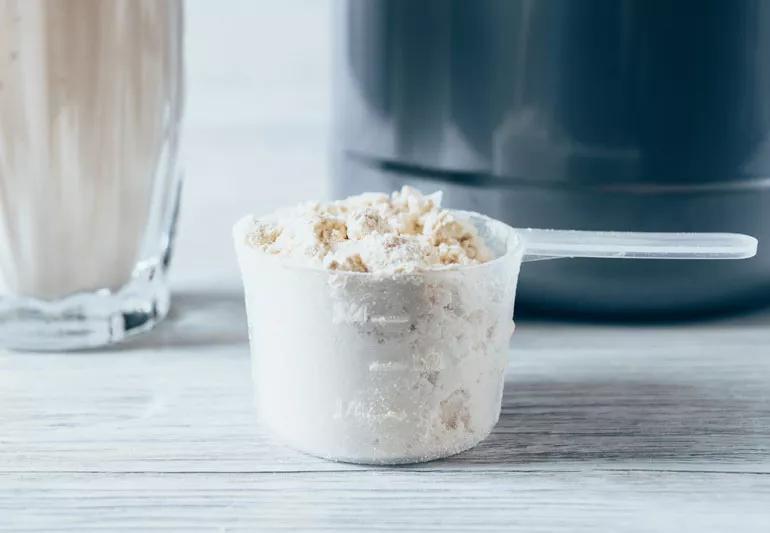Dumping dry protein powder in your mouth is dangerous — and maybe even deadly

If your first lift for a workout involves raising a scoop of dry protein powder to dump in your mouth, it’s time to rethink your routine.
Advertisement
Cleveland Clinic is a non-profit academic medical center. Advertising on our site helps support our mission. We do not endorse non-Cleveland Clinic products or services. Policy
Researchers say the practice known as “dry scooping” qualifies as dangerous — and even potentially deadly. Add it to the list of questionable TikTok trends to explode onto the scene thanks to millions of video views.
Let’s look at the risks with dietitian Kate Patton, MEd, RD, CCSD, LD.
To start, let’s look at what is being scooped: pre-workout powder. Most powders are packed with caffeine and other stimulants, plus various vitamins and nutrients. They’re designed to supercharge your system and provide energy for a workout.
Traditionally, pre-workout powder is added to water and consumed about a half-hour before putting your muscles to the test. Diluting the powder helps pace your body’s absorption of the product. Plus, it’s much easier on the tummy.
Dry-scoopers, however, take a different approach. They fill up a scoop with pre-workout and dump the powder in their mouth. A swig of water can help wash it down. (It is pretty chalky, after all.)
“Apparently, they think they’re noticing some kind of enhanced effect because the powder is absorbed faster,” says Patton.
But that effect comes at a cost.
Dry scooping essentially floods your system with caffeine with one swallow. Your blood pressure and heart rate may skyrocket as your body takes in the stimulant, particularly as you start exercising.
Advertisement
The jolt of caffeine — which could be equivalent to three or more cups of coffee in an instant — could lead to an irregular heartbeat, too. “That sort of rush can cause palpitations,” says Patton.
In April 2021, a 20-year-old who tried dry scooping after seeing it touted on TikTok later posted a video on the social media platform from her hospital bed saying she was treated for a heart attack. (She survived.)
The use of TikTok to promote dry scooping is cause for concern given its reach among teens.
“This may mislead millions of impressionable minors into improper use of pre-workout, which could lead to respiratory or cardiovascular distress and/or death,” according to a study presented at the 2021 American Academy of Pediatrics National Conference and Exhibition.
Other risks of dry-scooping include:
“There is potential for a lot of harm,” says Patton. “If you’re going to use pre-workout powder, follow the directions and take it with water. You’ll still get the beneficial effects — just not as fast.”
Used correctly, it can be a useful tool for athletes in an intensive training program, says Patton. She emphasized, however, that the same basic results can be achieved through what you put on your plate.
“I’m not a believer, really, in using pre-workout,” she says. “Food is fuel and can give you all of the energy you need.”
But if you do use a pre-workout powder, Patton offers these recommendations:
And in regards to the last recommendation, that means no dry scooping.
Advertisement
Learn more about our editorial process.
Advertisement

The meat-based elimination diet restricts important food groups — like fruits and vegetables — that keep you healthy

The vitamins, minerals and other nutrients in the food you eat are essential for a healthy heart, but supplements are another story

Early research shows that this supplement may help, but more studies are needed

The natural supplement may help with weight loss, lower blood sugar and protect your heart

Over-the-counter pills, powders, extracts and tinctures can interact with other medications and cause unexpected side effects

There are plenty of claims that the pigment can improve acne, promote weight loss and more — but the research is lacking

This sticky phytocomplex may have health benefits — but the science and safety data is lacking

The pros and cons of taking prenatal vitamins when you’re not pregnant depend on your age, ethnicity and health

Babies can get congested easily, but you can calm their cough by keeping them hydrated, using nasal drops and running a humidifier

Weight loss may cause loose, sagging skin and muscle loss to your rear

Several conditions, like vitiligo and fungal infection, can cause a loss of pigmentation, leading to white spots or patches on your skin